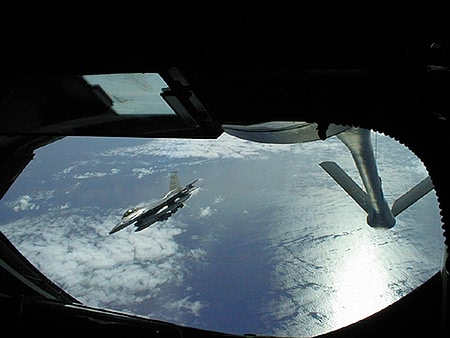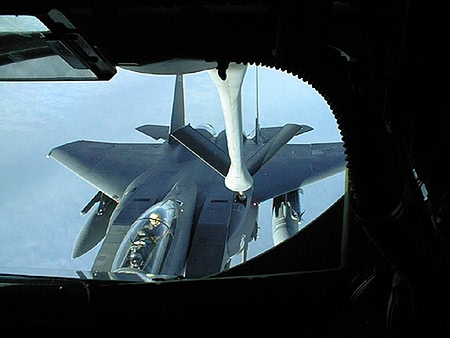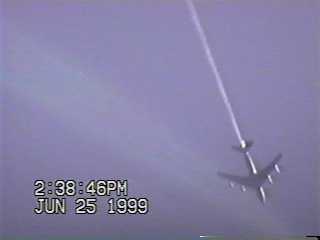-
- Mr. Rense,
-
- I listened to last night's (8-1-99) program today from
the archives about the chemtrail thing and just had to comment.
-
- I have some pretty strong feelings about this topic because
I'm a crew chief on KC-135's and have been for over 13 years. I've spent
a good deal of time deployed all over the world in the past year, or else
I would have tried to set the record straight on this a long time ago.
I'm aware that I have a lot more insight on the technical capabilities
of this aircraft than your average person, but some of these things I've
been reading on the internet are flat wrong.
-
- In all my years I have NEVER seen a KC-135, or KC-10
for that matter, that spread noxious gasses on anyone.
-
- There are a lot of pictures on the internet of aircraft
spreading contrails out of the end of the horizontal stabilizers on the
tail. This is also incorrect. If you look at any close-up picture of aircraft
contrails you will notice that the contrail actually starts a short distance
behind the engines exhaust. On a two engine jet aircraft (one engine on
each wing) it will generally be in line with the ends of the horizontal
stabilizer on the tail, thus giving the appearance that the contrail is
coming out of it.
-
- I have also had plenty of exposure to JP-8 jet fuel which
is pretty similar to kerosene. Because of the nature of my job, I'm exposed
to it virtually every day. For the several years that the Air Force switched
over to JP-8 from JP-4, I have not met anyone that has suffered any kind
of health problems from exposure to it. This includes friends of mine who
work in our Fuel Cell section and actually go into the empty fuel tanks
to make repairs. Don't get me wrong, they wear protective breathing equipment
because of the lack of oxygen in the tank, not because they will immediately
contract some kind of illness.
-
-
-

-
-
-
- I've also read online about orange or red KC-135's that
are supposedly training aircraft or belong to the Air National Guard. This
is also incorrect. All the KC-135's that I've ever seen are a flat gray
in color with black numbers and other markings used for identification.
There are orange and white aircraft used at Edwards Air Force Base, California,
but these aircraft are used as chase planes and experimental tests on those
particular airframes. At last count they didn't have any KC-135's or KC-10's
stationed there. As a matter of fact whenever they do any air refueling
there they use tankers from any of the assorted state side bases that have
those. I know this because I spent a month there several years ago while
the B-2 was still doing some testing and training. I will admit that what
some people may be seeing are KC-135's, but if they are dumping anything
it would be JP-8 coming out of the air refueling boom and not some type
of chemical or biotoxin.
-
- I realize that it may be alarming enough just to hear
that they are dumping JP-8 all over the place. This is actually not an
uncommon practice for any aircraft civilian or military because all aircraft
are supposed to be equipped with some kind of fuel dump capability. Why
would they be dumping this in the air you may ask? Well, the fact of the
matter is that the KC-135 can carry about 200,000 pounds of fuel when full.
It can take off with that much but it can't land with that much. If they
go to their designated refuel track and one of their recievers cancels
out or doesn't take as much fuel as was originally thought that means they
either have to dump the extra or fly around for a very long time just burning
it off. There are regulations about how long flight crews can fly and and
crew rest periods that I won't get into, but it is usually easier to dump
it than to fly it off. I don't necessarily agree with this particular point,
but that's how it works.
-
-

-
-
-
- When it is necessary to dump fuel they are given a certain
"track" to fly in to dump it. In most cases it isn't over large
cities but I have seen it happen. Usually this "track" isn't
a very large area so the KC-135 must fly in a very tight circle or actually
dump it in spurts over the "track". When they dump, it does come
out of the refueling boom in a large white stream which does look like
a very large, bright contrail. This would explain why some people would
report large circlular or criss-crossing contrails.
-
- In any case, the JP-8 will spread out and slowly dissipate,
usually slower than an average contrail. It will dissipate to the point
that it will be atomized long before it ever reaches the ground. If it
didn't, then anyone outside having a smoke underneath it would incinerate
several miles worth of real estate.
-
- There are also tales of a strange jelly substance full
of toxins raining down from these aircraft. I have never heard of JP-8
turning to jelly after being dumped and then plopping onto someone's house
or car, but I suppose if it combined with something else in the atmosphere
after being dumped it may be possible, but not very probable.
-
- I'm sure I haven't answered all of the questions that
have arisen about this topic, but I can only comment about what I have
actual knowledge of.
-
- ----
-
-
- I checked out that picture you were talking about on
- http://www.contrailconnection.com
- and that does appear to be a KC-135 dumping fuel. That
is exactly what it
- looks like.
-
-

-
-
- Courtesy of http://www.contrailconnection.com
-
-
- You see, the fuel is dumped through the same air refueling
boom you can see in the pictures I attached in my earlier email. Normally
it isn't lowered specifically for dumping but we maintainers like to ask
the aircrews to lower it during dumping simply because it tends to backflow
into the shrouded area on the end of the boom and then drain all over the
ground once they land. It tends to make a big mess and it's a dead give
away that they've been dumping fuel.
-
- If there any other questions about this topic don't be
afraid to ask. I'm just glad that I could actually help.
-
-
- Comments
-
- Takes Exception To Some Crew Chief Comments
-
- From Pam (data on file)
- 8-3-99
-
- Hi, Jeff.
-
- I am a former boom operator and was certified to fly
on 6 different models (R, RT, A, D, E and G) of KC-135 aircraft. I have
a few comments about what the crew chief said re: fuel dumping and fuel
load capacity.
-
- In my 6 years as a boom operator, I NEVER once had to
dump fuel. Neither did any of my peers that I was aware of. You see, although
the chief is right in saying the 135 can hold up to 200,000 pounds of fuel...he
neglected to say that 135's are NEVER loaded to that capacity in peacetime
unless they are sitting alert. (That means aircraft which are fueled to
capacity, geared up, pre-flighted, and ready to take off within 4 minutes
go to war - with flight crews sequestered in a high security facility
just waiting for the siren to go off.) The typical aircraft takes off
with around 70,000 - 100,000 pounds of fuel...and the aircraft can land
with that weight. So, again, dumping is more rare than he portrays. (I
know the fuel weights FOR SURE because the boom operator is the crew member
who figures the center of gravity of the airplane and must know exactly
how much fuel is in each indiviual tank. The co-pilot uses that information
for take-off and landing calculations.)
-
- Also, refueling in peace time is MERELY practicing making
contact between the planes, both for the boom and the reciever. None
(maybe only 1%) of the planes refueled during practice really need that
fuel to get to their destination. (The exception is support for war games,
such as Red Flag, held here in the Southwest - the fighters do need that
fuel.) In fact, several contacts are usually made between the boom and
each receiver, not always passing fuel. Sometimes, it's just practice
contacts. But, more often, a cursory amount of fuel is offloaded - typically
1,000 - 2,000 pounds (compared to 12,000 - 20,000 for Red Flag). Anyway,
the point: if there is a problem with a receiver not showing up, which
has happened to me numerous times, we simply GO HOME. No fuel dumping.
Just usually more touch and go (take-off and landing, a.k.a "crash
and dash") practice for the pilots. Period.
-
- Last point, we NEVER flew in any pattern other than large
ovals. No "X"s, no grids, no numerous lines...etc. Nothing
like that ever.
-
- The whole point I am making here is there are MANY more
mysterious contrail photos on the web than could ever reasonably be explained
by fuel dumping. It's just not common enough. And, the Air Force uses
fuel dumping as a LAST RESORT only, as dumping jet fuel into the atmostphere
is not considered to be "a good thing."
-
- There's my 2 cents.
-
-
-
- Mime-Version: 1.0
- Date: Mon, 2 Aug 1999 20:56:07 -0800
- To: neff1@mindspring.com
- From: eotl@west.net
- Subject: Mystery Chemtrails Comment
-
- Comment
-
-
- From Burt Tschach <bjt@saw.net
- 8-2-99
-
-
- Dear Jeff, If the explanation by the KC-135 crew chief
is his version of the gospel truth, then there are a great deal of planes
missing their scheduled refueling rendezvous. Frankly, I don't buy it.
The number of Chemtrails that have been seen seems completely out of line
with simple fuel dumping. The fact that many people have seen Chemtrails
repeatedly over large and small population centers alike flatly disputes
the statement that it rarely happens or they try to dump fuel in non-populated
areas. This reeks of disinformation. It was a nice try though. It tells
me that somebody is aware that people are onto the Chemtrails and explains
why there seems to be an effort afoot to camouflage them. Some of the ones
I have seen lately are really quite creative and if I hadn't seen them
laid out, I would have thought they were clouds. Thanks for your great
site and your great sense of fair play in presenting all sides of the issues.
If only the mainstream press were as wise.
-
- Burt from Portland
|